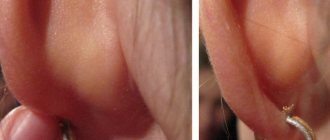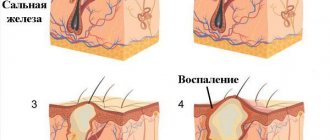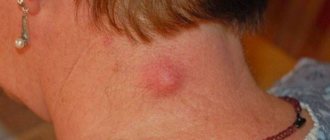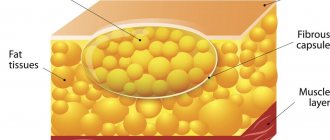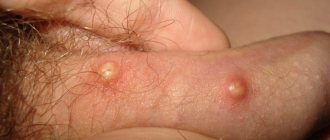Atheromas of the penis and scrotum (wen, sebaceous gland cysts) are benign cystic formations that, in the absence of complications, do not cause harm to the body. They are formed under the influence of certain factors in every fifth representative of the stronger sex, mainly upon reaching the age of twenty.
Neoplasms that are small in size do not cause any trouble, but due to their specific location they greatly reduce self-esteem. But a complicated form of pathology can lead to serious health problems.
Therefore, if any formation occurs in the intimate area, you should visit a dermatovenereologist or urologist, who will determine treatment tactics.
Causes
The causes of such tumors are called disturbances in the functioning of the sebaceous glands. This happens due to various factors. For example, the skin does not exfoliate well enough and dead skin cells do not come off, or the patient has hyperhidrosis. Doctors say that in many cases, heredity plays a key role - that is, a tendency to such a disease.
To the mentioned causes of atheroma we add the following:
- hormonal imbalance;
- high viscosity of sebum;
- problems with excretory function;
- work in which the skin is constantly covered with dirt and irritating substances;
- bad environmental influences;
- hygiene problems;
- cosmetics, antiperspirants and deodorants that narrow the ducts of the sebaceous glands.
These same factors can contribute to the development of other skin diseases.
Prevention of occurrence
Atheromas are associated with blockage of the sebaceous glands, so if pathology occurs, a man needs to control his diet. You will need to eliminate fatty foods. It is recommended to carefully observe intimate hygiene and remove sweat from the external genital area.
If strange formations are detected outside or inside the genital organs, it is recommended to consult a therapist and undergo instrumental diagnostics. The sooner a cyst is detected, the fewer complications it can cause.
Kinds
Skin atheroma can be true or false. The second is also called retention. True cysts are of nevoid origin (that is, similar to a nevus). They are formed specifically from the skin, and usually women suffer from such formations. Most often, such atheroma is located on the head, in the scalp. She grows slowly.
A false cyst grows from sebaceous clots when the gland is blocked. Both women and men have this problem. Similar atheroma occurs on different parts of the body, including in the labia area. She grew quite active and fast.
Why is a sebaceous gland cyst on the scrotum dangerous?
Even considering the fact that a growth in a man’s intimate area is a benign formation, it can provoke dangerous consequences. First of all, we are talking about the high probability of developing an inflammatory process. Inflammation of atheroma is observed in 75% of cases of the disease. With this development of the disease, pain occurs and the genitals become enlarged. Local and general body temperature increases. The person feels unwell. The skin in this area becomes red and increased sensitivity appears.
If this process is not stopped in time, the growth will soon begin to fester. Purulent masses will be released from the capsule of the formation, the pain will intensify, and swelling will appear. This condition requires immediate hospitalization. If the necessary measures are not taken, the disease can develop into sepsis. Tissue death (necrosis) will occur. A large ulcer forms.
Symptoms
Symptoms of atheroma include:
- formation (dense, spherical), filled with a light mass. It is usually white or light yellow;
- clear boundaries of the tumor. And if you click on it, the boundaries may shift;
- a noticeable duct of the sebaceous gland (but it may not exist);
- absence of pain as such. Exceptions are cases when the formations are constantly damaged, rubbed by clothing, etc.;
- location either in groups or one tumor at a time - both options are possible;
- sizes from 5 mm to 4 cm. Individual tumors of this type progress over the years, very slowly changing in size.
In connection with the last point, let us clarify that atheroma on the face or other part of the body usually develops in three variants. The first is breaking open and becoming an ulcer. The second is overgrowth with thick connective tissue. In such a situation, the tumor remains in its original form throughout the patient’s life and does not change. The third option is the most unfavorable - the tumor degenerates into malignant, that is, skin cancer develops.
Atheroma of the scrotum and penis in men: photo, removal
Atheromas of the penis and scrotum (wen, sebaceous gland cysts) are benign cystic formations that, in the absence of complications, do not cause harm to the body.
They are formed under the influence of certain factors in every fifth representative of the stronger sex, mainly upon reaching the age of twenty. Neoplasms that are small in size do not cause any trouble, but due to their specific location they greatly reduce self-esteem. But a complicated form of pathology can lead to serious health problems.
Therefore, if any formation occurs in the intimate area, you should visit a dermatovenereologist or urologist, who will determine treatment tactics.
Causes of atheroma on the male genital organs
The formation of cysts is preceded by blockage of the sebaceous glands or thickening of their secretion, preventing it from reaching the surface of the skin. As a result, closed cavities appear, consisting of capsules and yellowish cheesy contents that have an unpleasant odor.
Formations are more often diagnosed on parts of the body with a large number of sebaceous glands and hair follicles (axillary region, scalp, neck, back, face), and the testicles of men are no exception.
Blockages of the sebaceous glands and, as a consequence, wen are formed under the influence of certain reasons, such as:
- genetic predisposition;
- unbalanced diet (abuse of fatty, sweet and starchy foods);
- dysfunction of the sebaceous glands;
- excessive sweating, obesity;
- hormonal changes with increased testosterone production, diabetes, metabolic syndrome and other cases;
- systematic irritating or mechanical effects on the reproductive organs when wearing tight underwear made of synthetic fabric;
- injuries.
The main factors that provoke pathological processes include non-compliance with hygiene standards, which often happens in men.
Clinical manifestations and symptoms
Atheroma of the penis and testicles is a painless, dense, elastic, movable ball with clear outlines. In its central part, you can sometimes see a dark point - a clogged duct, from which, when pressed, the contents of the wen begin to be released. The skin over the cysts is not changed.
The formations tend to grow slowly and usually do not exceed one and a half centimeters in size; they can be single or multiple.
In severe cases, the development of atheromatosis cannot be excluded.
Numerous neoplasms in the form of bluish tubercles cover the entire surface of the scrotum. Pressing on them provokes the occurrence of sharp pain. As a rule, pathological processes occur against the background of other skin diseases (for example, seborrhea).
Treatment or removal of atheroma of the scrotum and penis
Atheroma of the scrotum and penis is treated only with the help of surgery, during which not only the contents of the wen are removed, but also its membrane. Although in this case, 3% of patients have relapses.
Any methods of conservative therapy, as well as folk remedies, can lead to getting rid of the formation, but at the same time its capsule remains in place, which provokes the re-formation of cysts.
As a rule, the prescription of drugs is due to the presence of anti-inflammatory and regenerative effects in them. They also show good effectiveness after surgery, because can prevent complications.
The most popular and effective remedy is Vishnevsky ointment. Its use as a compress at night leads to the release of the contents of the wen, and the antiseptic, regenerating and antibacterial properties of the drug prevent complications and promote rapid healing of the wound.
The choice of conservative methods of therapy should be made by a doctor.
Self-administration of medications can negatively affect the sensitive skin of the genitals and cause undesirable effects.
Surgery is necessary for:
- rapid growth of tumors;
- inflammation of nearby tissues;
- the appearance of acute or aching pain upon palpation of the affected area;
- the occurrence of unpleasant sensations - itching, burning;
- filling the cyst with purulent contents;
- insufficient blood supply to the male genital organs when the cyst is located at the site of vascular connections;
- obvious unaesthetic appearance of education, causing psychological complexes.
The most commonly used method is the classic removal of atheroma of the scrotum and penis - using a regular scalpel after eliminating inflammatory processes and suppuration.
Atheroma on the penis and scrotum can also be removed using modern methods, which are more expensive compared to classical excision, but are practically bloodless and rarely lead to complications. In addition, such methods are characterized by a short duration of the actual removal procedure, as well as a shortened rehabilitation period.
Good results are observed with laser removal of tumors.
There are several methods of using laser that allow you to get rid of fatty tissues of various sizes, even in the presence of inflammatory processes.
Radio wave removal and electrocoagulation are also effective methods for removing formations.
After the operation, the specialist gives recommendations on caring for the wound surface.
Danger of not treating atheroma
If the lump in the groin is small in size, does not tend to grow and does not cause discomfort, treatment may not be prescribed. In this case, it is necessary to constantly monitor the formation and at the first changes for the worse, you should consult a doctor.
Atheromas can rupture, which is fraught with infection, the onset of inflammatory processes, suppuration, phlegmon, ulcers, sepsis, and disruption of the functioning of the reproductive organ.
Complications are accompanied by pain, swelling and redness of the affected area, increased local and general body temperature, malaise, and discharge of purulent masses from the wen. These manifestations require urgent treatment, possibly in a hospital setting.
Preventive actions
Prevention of atheroma on the male genital organ includes compliance with hygiene requirements, using only special products intended for intimate hygiene, normalizing nutrition, and including only healthy foods in the diet.
It is necessary to exclude tight synthetic underwear from your wardrobe, which not only constantly squeezes and injures the reproductive organ, but also interferes with the normal flow of air.
It is necessary to minimize the risk of traumatic injuries to the penis and scrotum, as well as get rid of hormonal imbalances and diseases that provoke pathological processes.
Self-medication is unacceptable. Regular examinations by a doctor will help identify the cyst in the initial stages of development and prevent complications.
Source: //pro-rak.ru/dobrokach/ateroma-chlena-i-moshonki-u-muzhchin.html
Features of development in children
Since children rarely have hormonal imbalances, and the sebaceous glands work less intensively, this type of education for children is rare. If it appears, then it is atheroma on the head, in very extreme cases - in other places where the sebaceous glands accumulate.
At risk are children whose close relatives suffer from this problem, as well as children who are overweight and have hormonal disorders. For children under three years of age, mandatory removal of the formation is indicated. If the child is older, serious indications for surgical intervention are necessary.
Symptoms of disease in the groin area
This disease most often appears in young people over the age of 21.
This disease most often appears in young people over the age of 21. Signs of the disease are scanty. There is practically no pain. Soreness and redness appear during the suppuration stage. The scrotal cyst itself is fused to the surrounding tissue. A black dot is visible in the center of this formation. With complications, atheroma in the groin increases in size.
If the suppuration opens on its own, then most often a fistula forms. Sometimes the cyst capsule comes out along with the pus.
Atheroma on the penis is characterized by the following symptoms:
- Slight redness in the affected area.
- Skin irritation and development of itching.
- Local increase in temperature.
Multiple atheroma of the penis looks like a fine-grained structure in the form of papules.
Diagnostics
To diagnose atheroma on the back or other part of the body, the doctor first conducts an examination and interviews the patient. Then the patient is prescribed the following types of research:
- blood analysis;
- Ultrasound and MRI. Ultrasound is often prescribed, and MRI is prescribed only for certain types of localization; this is quite rare;
- histology. This is a study of an already removed tumor to understand what it is and whether it is malignant.
Diagnosis in this case is carried out quite quickly.
Treatment
The only treatment for atheroma that produces results is removal of the formation by surgery, laser or radio wave. The operation, as a rule, does not take much time (up to half an hour), is performed under local anesthesia and does not require too complex and lengthy rehabilitation.
If the situation is advanced and severe inflammation, infection, or an abscess has formed, emergency surgery is required. But in this case, the tumor is not removed, but only cleaned. Complete removal occurs after healing, after about three months.
Depending on the patient's initial condition after surgery, he may be prescribed antibiotics or other medications.
Treat or remove
Once the diagnosis has been made, the doctor will determine whether observation alone is required or surgical intervention is required. For small cysts without the risk of inflammation, observation is usually chosen. A diet with limited fatty and smoked foods and careful hygiene of the genitals with the help of special intimate gels are prescribed. If these measures are followed, cure usually occurs.
If the process is prone to progression or infection, then removal of atheroma of the scrotum through surgery is considered the most successful. Three surgical treatment methods are usually used:
- A classic operation for excision of a sebaceous gland cyst with desquamation of the capsule with its contents. Local anesthesia is usually used.
- Electrocoagulation. A modern and most effective method in which the risk of relapse is minimal.
- Opening and draining the cyst capsule (in case of purulent process).
In case of suppuration and inflammation, the cyst capsule is usually first opened and drained. Local and general antibiotic therapy is prescribed, and after the inflammatory process subsides, the atheroma is removed along with the sac.
There are several methods for treating atheroma
To open the atheroma yourself, you need to pre-steam with the use of antiseptics. However, after such removal there is a high risk of relapse, since the capsule, although it gets rid of its contents, remains in the same place, and the secretion of the sebaceous gland accumulates again. Ointments and traction compresses should be used after consultation with a doctor, as in some cases they can cause even greater blockage and progression of the process.
Among traditional medicines, decoctions of peony, primrose and wormwood have shown high effectiveness. They will be used as compresses after steam baths. It is worth consulting with your doctor about possible contraindications.
To reduce the risk of the disease, careful hygiene of the genital organs and weekly steam baths are necessary to open and naturally cleanse the sebaceous glands.
You should wear comfortable, non-squeezing underwear. It is worth giving up fatty, smoked and high-carbohydrate foods and maintaining a proper drinking regimen, since increased consumption of fats and carbohydrates increases the risk of developing skin pathologies leading to atheromatosis.
Benign formations of the male reproductive system include cavities that change the shape of the genital organs and cause superficial or internal deformation. The most common pathology of this type is a cyst in the scrotum, penis and epididymis. These formations can be combined with an infectious course. The appearance of cysts in most cases occurs in men aged 30-60 years.
Tumor and skin cysts are classified. The first include cavities that form inside the genital organs. They have an elastic structure, their walls do not extend outside the cover. A skin cyst on the penis or in another area is often accompanied by a violation of the upper skin layer, its walls are noticeably separated from the internal tissues.


